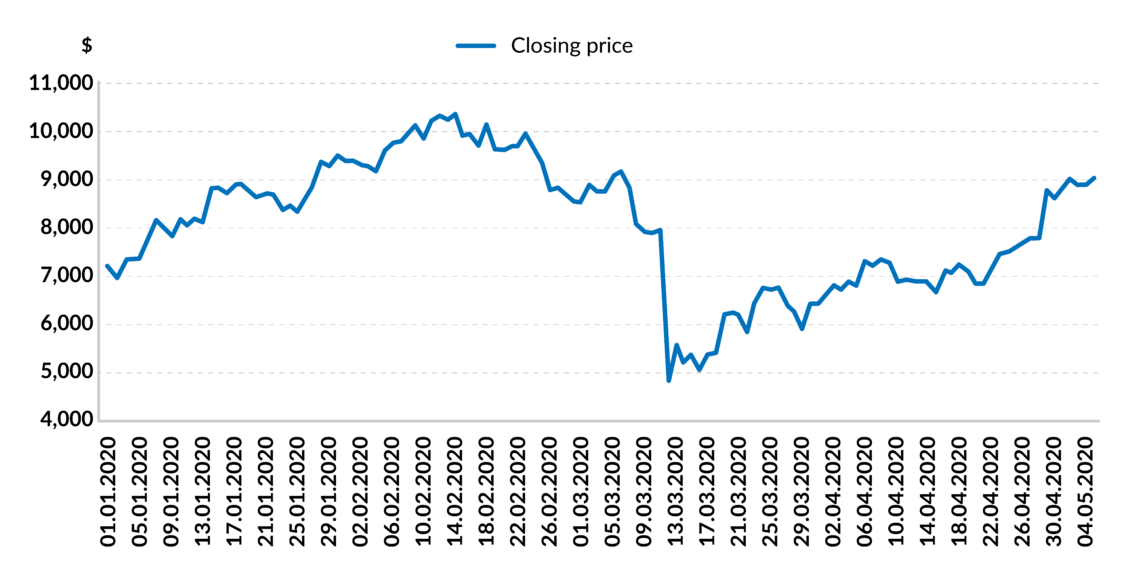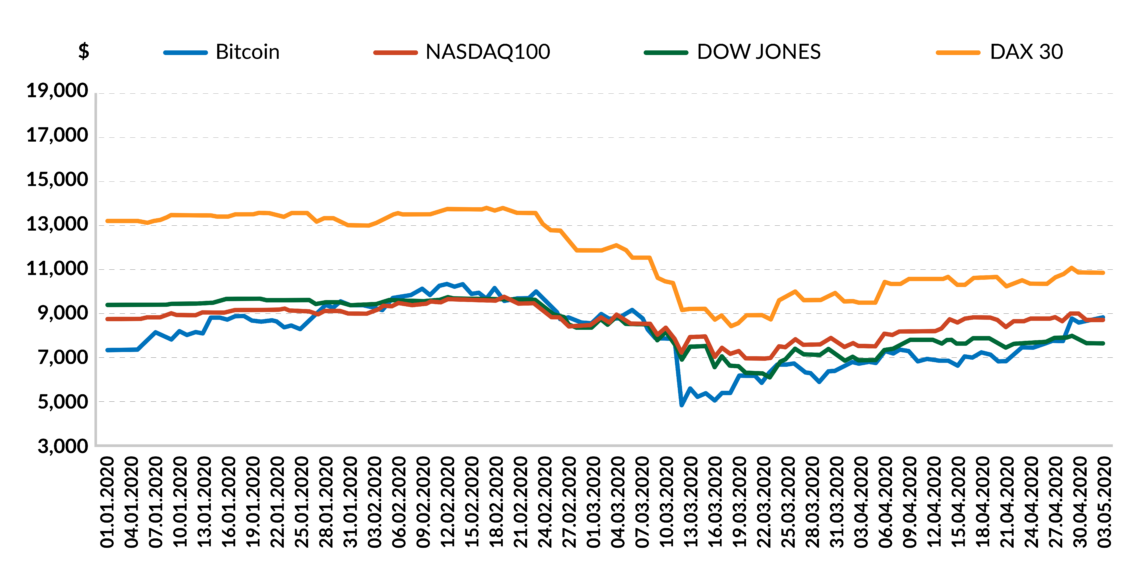Cryptocurrency: A store of value for the current crisis?
Now that the global economy is in deep recession because of Covid, investors are looking for crisis-proof stores of value – a need that cryptocurrencies could fulfill. Several European countries have already created legal frameworks.

In a nutshell
- The crisis will increase demand for alternative stores of value
- Cryptocurrencies are still affected by institutional reactions
- As Bitcoin becomes better known, its potential will grow
Due to the Covid-19 pandemic, the global economy and financial system are under greater strain than ever before. Citizens all over the world are asking themselves what value will remain constant, whether or not their money is safe and if governments and central banks are in control of the situation. To preserve value, the old options remain: real estate, gold, and currency. But some are also considering new forms of assets, like cryptocurrencies. Can Bitcoin act as a store of value? Can it be classified as a crisis-proof currency?
Crisis looming
Economists agree that the global economy is in deep recession, possibly one of the deepest ever measured. Uncertainty, debt levels and unemployment are increasing. The World Trade Organization (WTO) expects global trade to plummet by more than 30 percent in 2020.
Alternative means of value storage are coming under public scrutiny.
Governments and central banks are trying to limit the damage by injecting hundreds of billions of dollars into the economy. This will inevitably lead to dangerous debt levels in dozens of countries. The markets are flooded with money. Sooner or later, these moves could lead to a considerable loss of purchasing power, increasing the need for safe investments. As a result, alternative means of value storage like cryptocurrency are coming under public scrutiny.
New consequences
There is reason to believe individual countries’ currencies will likely come under pressure. The aggregate capital outflows from emerging countries like Brazil, Turkey, South Africa and Russia are increasing dramatically. According to the Institute for International Finance’s Deputy Chief Economist, Sergi Lanau, these outflows exceed those measured during the global financial crisis of 2007-2008. For example, the historical exchange rate of the United States dollar against the Mexican peso is at a historic high. During the crisis, the peso was devalued against the dollar by more than a third of its pre-pandemic value. As a result, it is becoming increasingly difficult for debtors in Mexico (or any other country with a devaluing currency) to repay their debts in dollars. This could destabilize many nations, creating a downward economic spiral.
The current rush into the supposedly stable dollar will probably continue. But under such volatile conditions, there will still be demand for alternatives that are global, widely accessible, and politically decentralized. Is cryptocurrency the answer? To establish whether Bitcoin and other cryptocurrencies can meet this demand, we first need to clarify if they can be considered scarce and secure enough. In theory, Bitcoin fulfills all the requirements, but in practice it is often not considered as such.
Facts & figures
Blockchain technology
Bitcoin is based on blockchain technology. A blockchain is a decentralized database that is protected against manipulation by cryptographic functions and linking mechanisms. All transactions are made visible for all participants in the network, so no transaction history can be modified or added later.
Originally, blockchain technology was developed as an alternative mechanism for establishing a basis of trust between transaction parties. Several transactions are combined into “blocks.” When a new block is created, it is cryptographically linked to previous blocks.
The general ledger of the network is managed individually by all parties connected to the system to check subsequent transactions for validity.
Bitcoin’s scarcity is one of its core characteristics since it is guaranteed by technology. However, understanding of this aspect is not yet widespread, so investors may not perceive the real intrinsic value of the currency. In the short term, therefore, it cannot be assumed that Bitcoin will develop into a fixed crisis investment, like gold. For example, there was a significant decline in the price of Bitcoin in March 2020 – a trend that closely followed the price of other asset classes. However, as the understanding of electronically guaranteed scarcity spreads and demand for cryptocurrency increases as a result, the price of Bitcoin could rise.
Digital gold
Bitcoin has been publicly declared dead several times. It has been deemed a scam and a Ponzi scheme. But the currency has so far been in circulation without technical problems for more than 11 years.
It is technically impossible to shut down; the technology is likely to still be around decades from now. While some may consider this a controversial statement, experts agree that the architecture of Bitcoin is very similar to that of gold. Gold mines use human hands, diesel, electricity and excavators; Bitcoin uses IT specialists, computer hardware and electricity.
The regulatory cryptocurrency infrastructure is constantly improving.
The adage goes that when stock markets collapse, the price of gold rises. And people frequently make that connection. For example, in August 2015, when stock markets crashed globally, the price of gold rose to almost $1,800. However, over long periods of time, there is a very low correlation between gold prices and stock indices like the S&P 500. The question is whether cryptocurrencies would behave similarly.
Both Bitcoin (BTC) and Ether (ETH) have shown a low correlation to major indices in the past. However, recent simultaneous price decreases in the traditional and crypto markets show that there might be at least a short-term correlation. Cryptocurrencies will not develop into a crisis investment like gold overnight, though, even if the conditions are right. For Bitcoin to become a safe haven, its market capitalization must continue to grow. That is the only way to contain the influence of individual market participants and reduce volatility.
Demand for Bitcoin would increase if investors better understood Bitcoin’s electronically generated and guaranteed scarcity. Meanwhile, the technical and regulatory cryptocurrency infrastructure is constantly improving. Liechtenstein was the first country to have official legislation for blockchain, the Liechtenstein Blockchain Act. Germany followed with a similar “crypto-license” that came into force on January 1, 2020. Banks, asset managers, financial service providers and stock exchanges can now also invest in cryptocurrency on behalf of their clients. This increased accessibility at the institutional level will certainly affect prices soon. Moreover, it constitutes an important milestone toward recognizing cryptocurrencies as a reliable, universal storing medium with low barriers to entry.
Facts & figures

Crisis resistance
Cryptocurrencies were born almost a decade ago, in the aftermath of the mortgage crisis and amid a sharp rise in unemployment. Confidence in the economy and in the financial sector was at a historic low. In 2008, the domain bitcoin.org appeared, registered under the pseudonym Satoshi Nakamoto. The site featured a white paper entitled “Bitcoin: A Peer-to-Peer Electronic Cash System.” This marked the beginning of the currency’s existence. In 2009, its first year, Bitcoin’s value was not comparable to that of a state currency. Between 2010 and 2013 one Bitcoin was rarely worth more than one dollar, except for short-lived leaps in prices.
Facts & figures
Non-state currency
Bitcoin is an unusual currency in many regards. It is based on new technology (see the blockchain box) and is not officially recognized by any state.
When the U.S. government requires payment in dollars, it creates a demand for its own currency. Governments demand that taxes be paid in the currency of the state, limiting the use of non-state currencies. However, Bitcoin’s unique technical structure has nevertheless attracted investors.
The cryptocurrency hype began to take off from 2013 onward. This was also the beginning of a real price explosion for Bitcoin, which was subsequently characterized by high price volatility. In 2017, the currency once again came into the limelight and more and more people became familiar with the technology from an investor’s perspective. Nevertheless, Bitcoin prices remain highly volatile, as the asymmetrical relationship between investment activity and knowledge of the technology continues to exist.
To assess whether cryptocurrencies can be viable stores of value, it is worth looking at their behavior during crises. The overview of the world’s leading stock market indices below clearly shows that Bitcoin has reacted in a more volatile manner than the established and consolidated leading economic indices. Bitcoin does not seem to function independently of leading indices yet. However, it and other cryptocurrencies may begin to do so as investors’ understanding of its scarcity develops.
Bitcoin does not seem to function independently of leading indices yet.
If cryptocurrencies are to become a safe investment comparable to gold, more education is needed. In most cases it is a lack of knowledge that prevents investors from getting better acquainted with the technology, rather than a lack of legislation (even if some legal hurdles still need to be cleared). Europe – Liechtenstein, Switzerland, and Germany in particular – is very progressive and has created a framework within which this innovation can succeed.
Scenarios
The Covid-19 crisis could lead to two distinct scenarios with respect to cryptocurrencies like Bitcoin.
Immediate push
The first scenario could materialize during the current crisis. Corporate and private budgets would be used to explore the field of cryptocurrency and blockchain technology to overcome the crisis. In the next few months, there would be increased innovation and dissemination of knowledge in this field. This is a likely scenario, especially in view of the renewed interest in Bitcoin. However, this would require balancing the asymmetrical relationship between knowledge about blockchain technology and its use as an investment as quickly as possible.
Postcrisis push
Under this second scenario, the current crisis would initially act as a barrier to blockchain. Since budgets would focus exclusively on securing liquidity with known and proven means of value storage, innovation would be halted. Post-pandemic, however, the weaknesses of different assets and processes would be uncovered. Cryptocurrencies as an investment would gain popularity to avoid those pitfalls.
New regulations and the dissemination of knowledge about the technology will have a decisive effect on the likelihood of the above-mentioned scenarios. Technically inclined countries like Liechtenstein, Switzerland and Germany have created a solid basis for the first scenario. Other countries are more likely to seek out new methods of value storage only once the crisis is past, as safety and the use of best practices are a priority in the face of acute liquidity situations.






